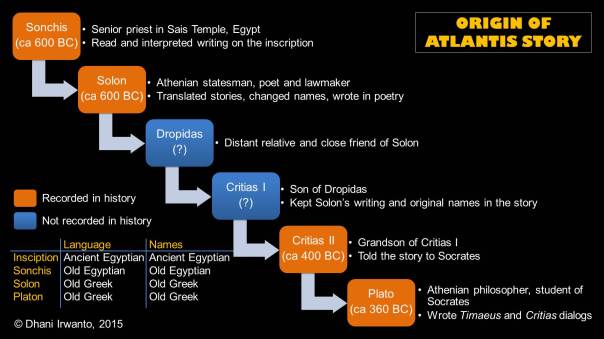A research by Dhani Irwanto
Plato writes that Solon, while wrote his poem, enquired into the meaning and knowledge of the names and had translated them into their own language; when copying them out again translated them into Greek. Thus, the names include Poseidon, Heracles, Atlas, Athens, Egypt, Libya, Tyrrhenia and Europe are translated names which the originals were kept by Critias.

In the mythology of the Egyptians, the island and the lake of Neserser or Nesisi, “the island and the lake of flames” where Osiris[1] and Thoth[2] came from, is often mentioned in their myths. As described in the Papyrus of Nu (in the Book of Dead), the myth tells that Osiris has his throne on the island of Neserser in the center of six or seven concentric circles with a gate at each and its all in the “lake” of Neserser. The concentric circles were built for Ra by the dwellers of the lake. Thoth had his lands around the lake and he visited Osiris on the island. There was a great flood in the lake of Neserser and somehow these circles of Ra became hidden.
As written in many tomb texts from the Middle Kingdom and the Second Intermediate Periods, in the concepts of the divinities and the deceased, the Neserser island is a heaven-like place, a place where judgement is passed and the deceased is reborn equipped with a status (god or common being). The Hetep-fields is a kind of paradise under the supervision of the god Hetep with whom the deceased identifies himself, and where he leads the happy life reserved for the privileged (Englund in Demarée 1983). In the concept, Osiris, Horus[3] and Thoth were given the status of gods or ancestral divinities.
The description of Neserser is parallel to the story of Atlantis. Six or seven concentric circles were built for Ra on the island of Neserser, conforming to the Atlantis’ four circles of lands (including the central land) and three circles of water, built by Poseidon. Either Osiris or Atlas have their thrones on the central lands. The lake of Neserser is conforming to the almost closed sea around the Atlantis capital island. Plato describes the sea as a water with a mouth to the outer sea, thus arbitrarily can be called a lake. As described above, the author make a hypothesis that the sea is the ancient Java Sea (Irwanto, 2015). There was a great flood in the lake of Neserser which devastated the island of Neserser, and then it was hidden. This is also parallel to the descriptions about the destruction of Atlantis.
Read also: Nusasura: The Atlantis Island?
[1] Osiris was an Egyptian god, usually identified as the god of the afterlife, the underworld, and the dead, but more appropriately as the god of transition, resurrection, and regeneration. He was classically depicted as a green-skinned man with a pharaoh’s beard, partially mummy-wrapped at the legs, wearing a distinctive crown with two large ostrich feathers at either side, and holding a symbolic crook and flail.
[2] Thoth or Djehuti was one of the deities of the Egyptian pantheon associated with the arbitration of godly disputes, the arts of magic, the system of writing, the development of science, and the judgment of the dead, often depicted as a man with the head of an ibis or an ape, animals sacred to him.
[3] Horus is one of the most significant ancient Egyptian deities, the son of Isis and Osiris, and he plays a key role in the Osiris myth as Osiris’ heir and the rival to Set, the murderer of Osiris.